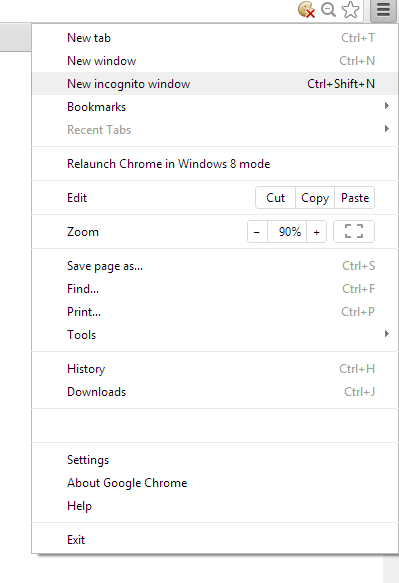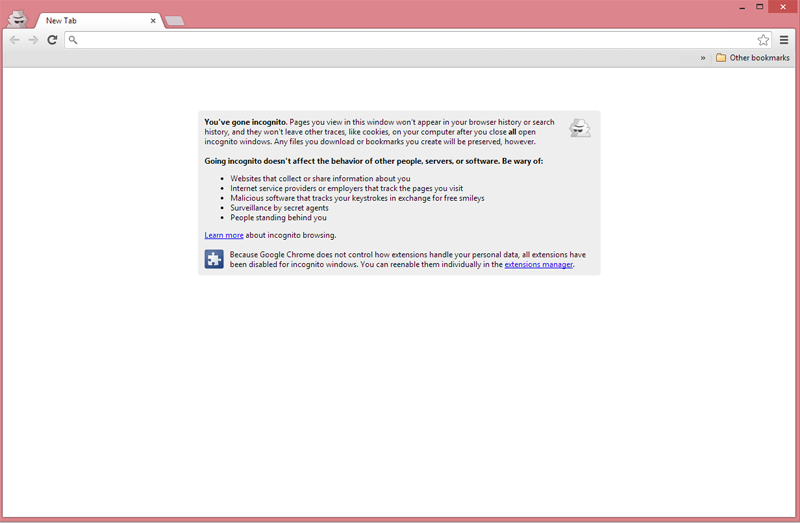 3. A new window will open with the incognito icon in the upper left corner.
3. A new window will open with the incognito icon in the upper left corner.

 3. A new window will open with the incognito icon in the upper left corner.
3. A new window will open with the incognito icon in the upper left corner.

 Regarding web-browsing for the iOS, Google Chrome doesn’t bring much new to the table. Chrome basically the same features as Safari for the iPad; voice-search is perhaps the most interesting feature. For the Ipad it’s a bit unnecessary but for the Iphone voice search is very convenient and worked well when we tested it.
The iOS version of Google Chrome is very similar to the desktop, the navigation is the same but it’s possible to browse between tabs by swiping across the screen. To the right there is a menu with a bunch of options and features. For example the incognito mode is available in the iOS-version, and also the ability to view web-pages as the desktop version of Chrome. Obviously Google Chrome for iOS has no support for flash-websites.
The whole idea with Google Chrome for the iOS is of course that you can sync bookmarks between different devices using Chrome, it’s also possible to continue a browsing session on your desktop, for example opening a tab previously viewed on your iPad or iPhone.
Apple have carefully plotted so that third party browsers in the iOS can’t benefit from the much faster Nitro java-script engine available in Safari, this means that Google Chrome is a bit slower than Safari. However it is barely noticeable and it actually feels snappier than for example Atomic web and other third party browsers.
A major downside with the Chrome browser is the way Google have chosen to structure the bookmarks, they are actually part of the browsing experience and not in the sidebar to the right as in the original desktop version. As a result it’s harder to find relevant bookmarks.
Google Chrome for iOS is mainly aimed at current users of the desktop version, and it really provides much better functionality than Safari. However few current desktop Safari users will probably migrate.
Regarding web-browsing for the iOS, Google Chrome doesn’t bring much new to the table. Chrome basically the same features as Safari for the iPad; voice-search is perhaps the most interesting feature. For the Ipad it’s a bit unnecessary but for the Iphone voice search is very convenient and worked well when we tested it.
The iOS version of Google Chrome is very similar to the desktop, the navigation is the same but it’s possible to browse between tabs by swiping across the screen. To the right there is a menu with a bunch of options and features. For example the incognito mode is available in the iOS-version, and also the ability to view web-pages as the desktop version of Chrome. Obviously Google Chrome for iOS has no support for flash-websites.
The whole idea with Google Chrome for the iOS is of course that you can sync bookmarks between different devices using Chrome, it’s also possible to continue a browsing session on your desktop, for example opening a tab previously viewed on your iPad or iPhone.
Apple have carefully plotted so that third party browsers in the iOS can’t benefit from the much faster Nitro java-script engine available in Safari, this means that Google Chrome is a bit slower than Safari. However it is barely noticeable and it actually feels snappier than for example Atomic web and other third party browsers.
A major downside with the Chrome browser is the way Google have chosen to structure the bookmarks, they are actually part of the browsing experience and not in the sidebar to the right as in the original desktop version. As a result it’s harder to find relevant bookmarks.
Google Chrome for iOS is mainly aimed at current users of the desktop version, and it really provides much better functionality than Safari. However few current desktop Safari users will probably migrate.
 Yahoo Axis is available for desktops (PC and MAC), the Ipad and the Iphone, a search made on the desktop computer can be continued on an Iphone. All bookmarks and read later lists are also synced between the different devices. Yahoo Axis is lacking apps for Android and Windows Phone, which hopefully will be brought to the table shortly.
On the desktop Yahoo Axis is downloaded as an extension to an already existing browser, such as Chrome, Firefox or Internet Explorer 9. When Axis was released there a security issue with the Chrome extension, this has since then been fixed by Yahoo. Some blogs reported that Internet Explorer 9 and other browsers were slowed down when surfing the web, it was noticeable in IE 9 but not any of the other browsers, even-though the extension itself sometimes took a while to load it didn't affect the performance of the browser. The general behavior of the extension in Google Chrome was also a bit awkward, sometimes it opened, sometimes it didn't.
The Ipad/Iphone apps is really where this product comes to real usage, the interface in Yahoo Axis is perfect for cell phones and tablets. For example Axis shows more relevant info about a website before loading it, making it much easier to use on the Iphone than Safari, which relies on Google who basically have the same layout as on the desktop.
The sync between devices works well, for example it is simple to research something on the desktop and then continue on a mobile device on the go. Yahoo Axis has support for Google and Facebook-accounts, so a Yahoo account is not needed just to use this product.
Yahoo Axis has a home-screen with a list of bookmarks and read-it later items. Adding bookmarks was no problem but adding sites to the read-later list was sometimes a struggle, for example we I added an article in Wired to read-it later, but it didn't show up.
When searching long tail keywords Yahoo Axis is not that powerful as Google, it simply doesn't find the in-depth stuff that Google do, and even if it does it's still hard to tell from the results which hits are good and which aren't. Searches in other languages than English returns mixed results, it's not uncommon for Yahoo Axis to mix different languages in its results (for example Norwegian and Spanish). The search engine used as with all Yahoo products is Microsoft Bing.
Axis handles the standard searches such as text and images just fine, but it lacks news and video search making it difficult to use as a sole search engine, Yahoo says that they will add additional options over time.
Yahoo Axis is a good concept, and has the perfect timing, it is however too bad that the browser extensions for browsers need some polishing. As Google is getting more comfortable in their total ownage of the search market, and seem to be focusing on Android and driver-less cars, the field is open again for innovation products, such as Yahoo Axis.
Yahoo Axis is available for desktops (PC and MAC), the Ipad and the Iphone, a search made on the desktop computer can be continued on an Iphone. All bookmarks and read later lists are also synced between the different devices. Yahoo Axis is lacking apps for Android and Windows Phone, which hopefully will be brought to the table shortly.
On the desktop Yahoo Axis is downloaded as an extension to an already existing browser, such as Chrome, Firefox or Internet Explorer 9. When Axis was released there a security issue with the Chrome extension, this has since then been fixed by Yahoo. Some blogs reported that Internet Explorer 9 and other browsers were slowed down when surfing the web, it was noticeable in IE 9 but not any of the other browsers, even-though the extension itself sometimes took a while to load it didn't affect the performance of the browser. The general behavior of the extension in Google Chrome was also a bit awkward, sometimes it opened, sometimes it didn't.
The Ipad/Iphone apps is really where this product comes to real usage, the interface in Yahoo Axis is perfect for cell phones and tablets. For example Axis shows more relevant info about a website before loading it, making it much easier to use on the Iphone than Safari, which relies on Google who basically have the same layout as on the desktop.
The sync between devices works well, for example it is simple to research something on the desktop and then continue on a mobile device on the go. Yahoo Axis has support for Google and Facebook-accounts, so a Yahoo account is not needed just to use this product.
Yahoo Axis has a home-screen with a list of bookmarks and read-it later items. Adding bookmarks was no problem but adding sites to the read-later list was sometimes a struggle, for example we I added an article in Wired to read-it later, but it didn't show up.
When searching long tail keywords Yahoo Axis is not that powerful as Google, it simply doesn't find the in-depth stuff that Google do, and even if it does it's still hard to tell from the results which hits are good and which aren't. Searches in other languages than English returns mixed results, it's not uncommon for Yahoo Axis to mix different languages in its results (for example Norwegian and Spanish). The search engine used as with all Yahoo products is Microsoft Bing.
Axis handles the standard searches such as text and images just fine, but it lacks news and video search making it difficult to use as a sole search engine, Yahoo says that they will add additional options over time.
Yahoo Axis is a good concept, and has the perfect timing, it is however too bad that the browser extensions for browsers need some polishing. As Google is getting more comfortable in their total ownage of the search market, and seem to be focusing on Android and driver-less cars, the field is open again for innovation products, such as Yahoo Axis.
 It is a bit surprising that visual themes (or Personas as Mozilla likes to call them) have not been implemented widely in web-browsers until now. Using Personas is easy, go to the website GetPersonas.com and browse the gallery. Then select "Wear this" and Firefox 3.6 Beta is updated without any restart required. Most of the different personas look very good making Firefox integrate better with the nicely looking Windows Vista and 7 user interface. Until now I always thought that Firefox had a dated look but now it appears that Mozilla have solved the problem. Of course visual themes is not what makes a good web-browser but one have to recognize that there are probably many users out there who wants this.
A lot of users of Mozilla Firefox have been using old and unpatched plug-ins causing various security concerns and browser instability, Firefox now have the Mozilla Plug-in Check integrated in the browser. When the users visits a page trying to load an out-of date plug-in an alert will pop-up. It can of course always be discussed if alerts are the right way to handle update issues, for example Microsoft have moved more towards providing automatic updates without any user interaction.
Supposedly Firefox 3.6 Beta is faster and handles JavaScript more swiftly than previous versions. Of course it is something that it is impossible to measure since the performance enhancements will not be that noticeable for average users. However there is nothing wrong with the browser's responsiveness. The start-up time has clearly been improved and using JavaScript based applications does seem faster.
Full screen video support in Firefox 3.6 has been improved, however the full screen features implemented only works when using HTML 5. This means that most sites will not benefit from the new video feature in Firefox, since the video capabilities in HTML 5 is not used that widely. Another new feature in Firefox 3.6 is improved support for Windows 7, when hovering over Firefox's taskbar entry in the different tab that you have open will show up.
Overall Firefox 3.6 Beta 1 contains a bunch of welcome updated, where Personas and plug-in alerts is the most welcome. However Firefox 3.6 is still a minor update compared to previous versions.
It is a bit surprising that visual themes (or Personas as Mozilla likes to call them) have not been implemented widely in web-browsers until now. Using Personas is easy, go to the website GetPersonas.com and browse the gallery. Then select "Wear this" and Firefox 3.6 Beta is updated without any restart required. Most of the different personas look very good making Firefox integrate better with the nicely looking Windows Vista and 7 user interface. Until now I always thought that Firefox had a dated look but now it appears that Mozilla have solved the problem. Of course visual themes is not what makes a good web-browser but one have to recognize that there are probably many users out there who wants this.
A lot of users of Mozilla Firefox have been using old and unpatched plug-ins causing various security concerns and browser instability, Firefox now have the Mozilla Plug-in Check integrated in the browser. When the users visits a page trying to load an out-of date plug-in an alert will pop-up. It can of course always be discussed if alerts are the right way to handle update issues, for example Microsoft have moved more towards providing automatic updates without any user interaction.
Supposedly Firefox 3.6 Beta is faster and handles JavaScript more swiftly than previous versions. Of course it is something that it is impossible to measure since the performance enhancements will not be that noticeable for average users. However there is nothing wrong with the browser's responsiveness. The start-up time has clearly been improved and using JavaScript based applications does seem faster.
Full screen video support in Firefox 3.6 has been improved, however the full screen features implemented only works when using HTML 5. This means that most sites will not benefit from the new video feature in Firefox, since the video capabilities in HTML 5 is not used that widely. Another new feature in Firefox 3.6 is improved support for Windows 7, when hovering over Firefox's taskbar entry in the different tab that you have open will show up.
Overall Firefox 3.6 Beta 1 contains a bunch of welcome updated, where Personas and plug-in alerts is the most welcome. However Firefox 3.6 is still a minor update compared to previous versions.



By continuing to use the site, you agree to the use of cookies. more information
The cookie settings on this website are set to "allow cookies" to give you the best browsing experience possible. If you continue to use this website without changing your cookie settings or you click "Accept" below then you are consenting to this.